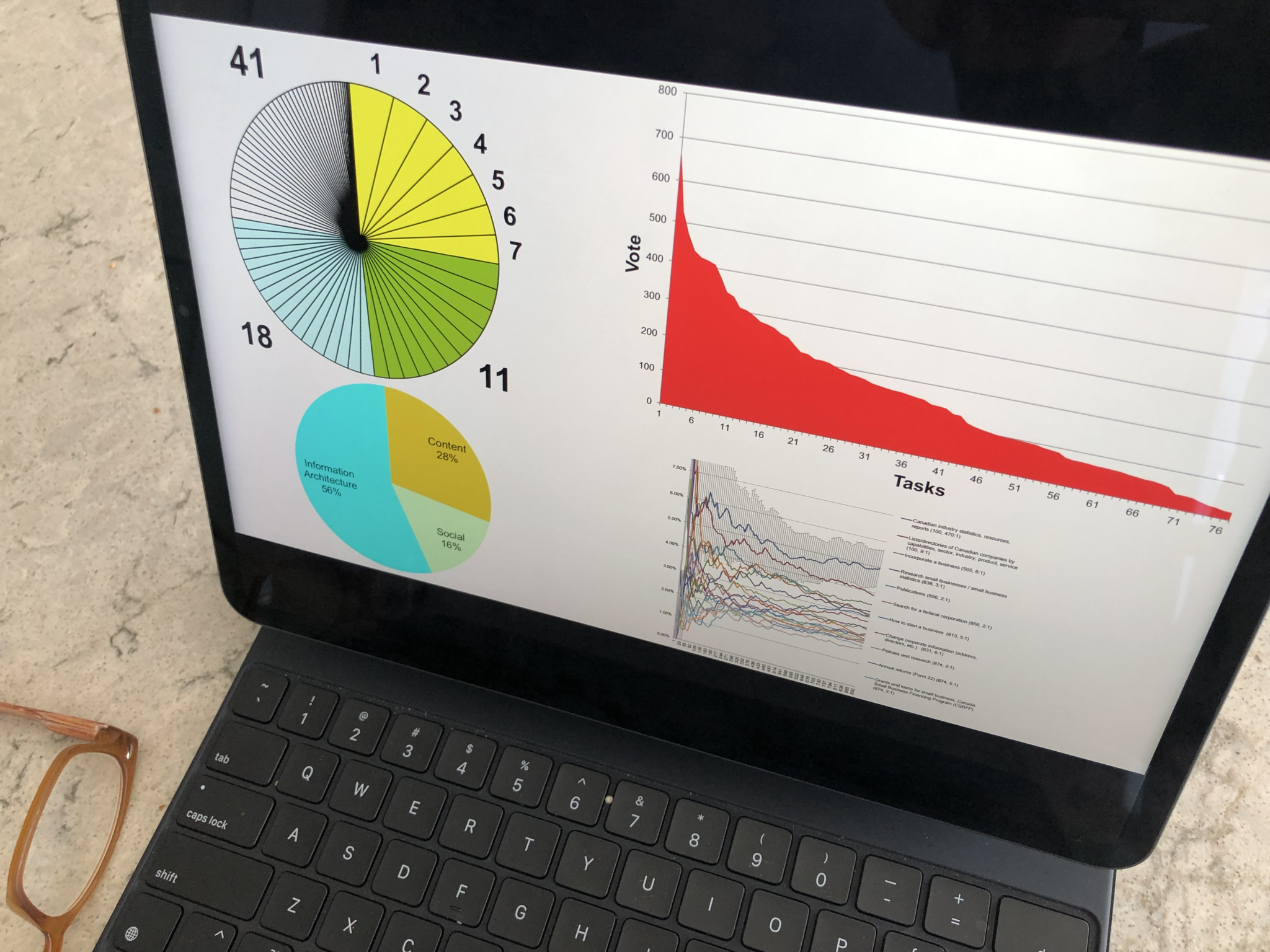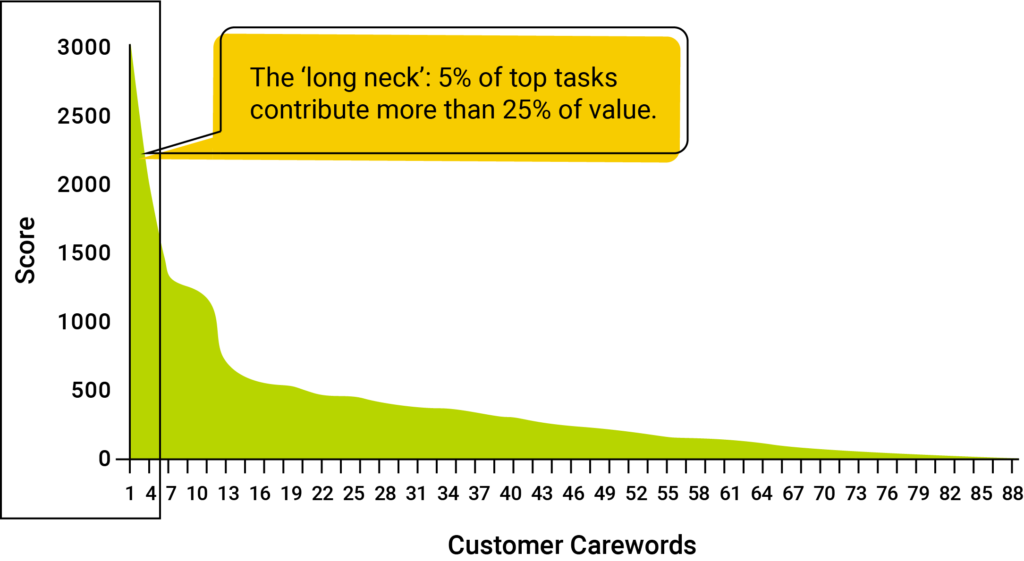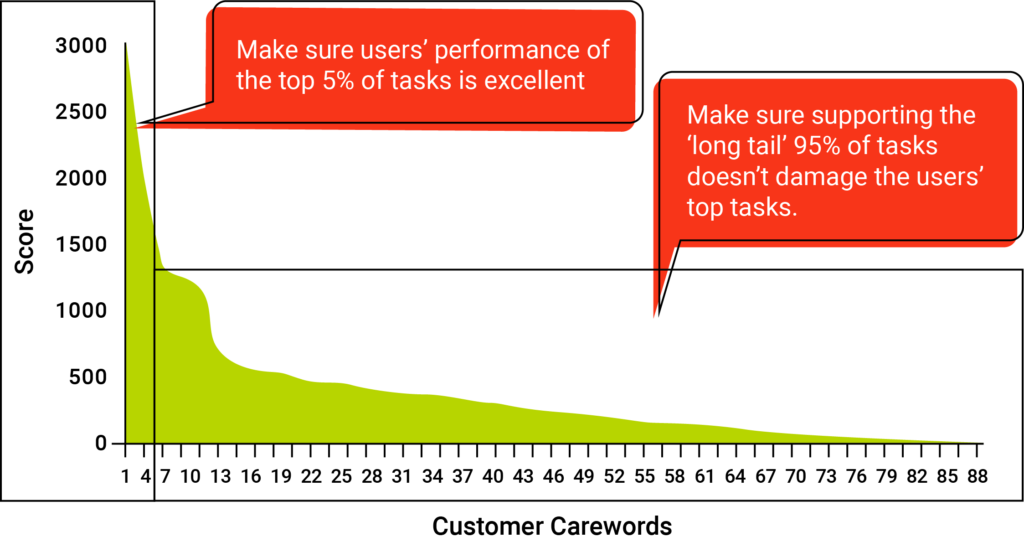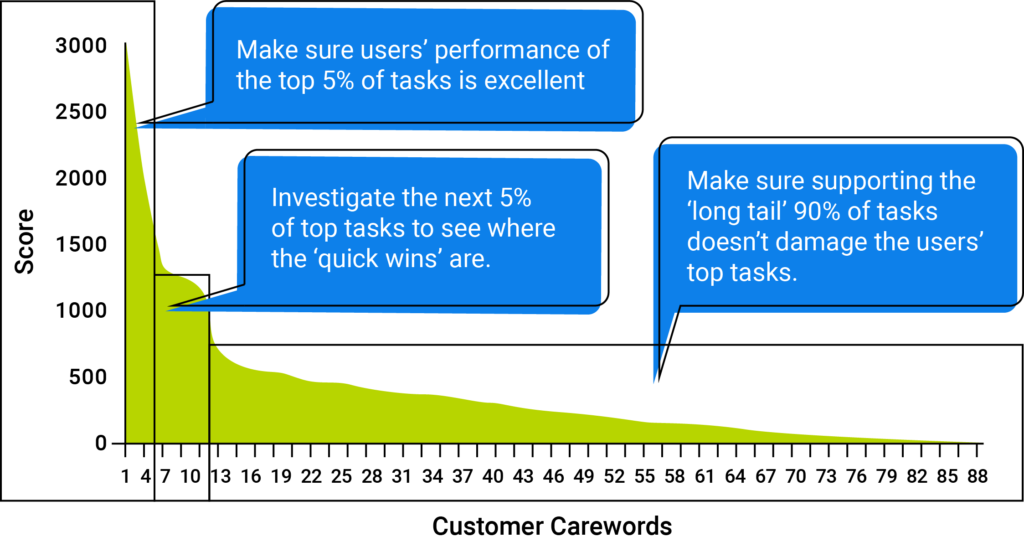The best website management strategy wrapped up in one slide

Published on
Author
Share
Focusing on top tasks will give you a customer-centric website and direct management’s attention where it counts.
The process of identifying clients’ top tasks is more than a usability process; it’s a management process. Above and beyond producing hard evidence of users’ priorities and functions, a top tasks identification project generates focus and commitment from key stakeholders to a customer-centred management strategy. The process generates actual customer data, precise and statistical, from a unique voting process.
Data derived directly from customers; data about not their feelings and opinions, but their top tasks. Data that can be used over and over again to counter strong opinions and turf-wars in strategy and planning meetings (“The Minister wants his photo on the home page,” “The President thinks her welcome message should be prominent,” “We need to promote this product,” and so on).
Every website has a “long neck” of top tasks
Across 100+ top task identification projects that we, Gerry McGovern, and our partners have undertaken, we always – without exception – find a “long neck.” Whether it’s a public website, an intranet, or a commercial, government or education site doesn’t matter.
The “long neck” is the very small set of top tasks that visitors want and need to carry out quickly and successfully, time and time again. We find that around five percent of top tasks represent more than 25 percent of a site’s value to its users. The long neck of top tasks is the business case for any website.
Put an end to debates about what should and shouldn’t be on your website or home page, or in the navigation links, with defensible, compelling data that shows exactly what your customers want.
The chart below shows the results of one poll of intranet tasks from an organization of more than 30,000 users. More than 2,000 employees voted on and prioritized their top tasks from a list of more than 100 tasks. As usual, an overwhelming number of the votes went to a small handful of tasks (For example, “Find a person” is almost always the top task for an intranet).

This is what makes top task data so valuable. It is real customer data, showing unequivocally what the top tasks are on any website and how important they are relative to all the other tasks. We often find that the top five to ten percent of tasks get about 35 to 45 percent of all votes. In a few instances, the top tasks account for more than all the other tasks combined!
Success strategy: Focus on top tasks
One of the key challenges to strategic thinking is a lack of focus – having too many initiatives, trying to please too many people, serving too many masters, failing to communicate a clear vision to staff, and so on. We see many senior managers and organizations struggling with a lack of strategic focus for their public web presence and intranets. Managers cannot build strategic momentum if they lack evidence that will compel stakeholders. They need hard evidence of where to focus and where not to focus. As Michael Porter points out:

Strategy renders choices about what not to do as important as choices about what to do… Some managers mistake ‘customer focus’ to mean they must serve all customer needs or respond to every request…”
Scott Smith

Data provides a focus
Web teams are overwhelmed and need a way to prioritize work. But the user has no seat at the table. A top task management project helps web managers set and hold priorities. It encourages a laser-sharp focus on the top tasks that deliver value to your users. It’s usually an amazingly small number of tasks. That is the kind of focus needed to allocate resources to the strategic value of a website.
This sharp focus will lead to the following:
- A more customer-focused website: A truly customer-centric website with content that speaks the customers’ language, not the organization’s lingo.
- Management based on facts, not opinions: No more endless debates about what should and shouldn’t be on your website or home page, in your communications, or in navigation links. Reliable, defensible, compelling data that shows exactly what your customers want – and don’t want.
- A simpler website: Strip away all the filler content from your website. Create a clean, lean website that focuses on what your customers care about most.
- Task data supports a laser-sharp focus on the top tasks that deliver value to your users.
Website management strategy in one slide
So, what’s that strategy and chart we talked about earlier? Here it is:

Simple, huh? Just two elements:
1. Make sure your users’ performance on the top 5% of tasks is excellent
You must get your team focused on ensuring customers achieve excellent performance on the top tasks. You first need to discover and measure how well customers are able to perform these tasks now. Then, set tough but achievable targets to improve performance to excellent, including:
- Get top task completion by target users as close to 100% as possible
- Get task time on top tasks close to the optimal time
- Get “disaster” rates on top tasks close to 0%
Read more about these metrics in Gerry McGovern’s Top Tasks book.
“Ignore” may be a bit radical and (intentionally) provocative. But, if you want those big wins and want to pull your web strategy out of the mire we see in many organizations, you may need a short-term plan as radical as this. Maybe this is the kind of chart that can jolt the management team awake at the next strategy meeting.
We see so many organizations with large websites struggling with strategy. After 15 years of publishing on the web, their strategy has become overwhelmed. Unless you have a well-defined business model that incorporates the 95% of lower-priority user tasks, the risks in trying to deal with them are:
- Too many people will need to be involved.
- The politics will become more problematic.
- It will take significant effort away from the top 5% (even just quantifying the problems will require substantial resources!).
- There still won’t be enough resources allocated to do a good job.
- Management decisions will get harder to make.
- It will be more difficult to show real progress that delivers business value.
We’re essentially saying that, for many organizations, the most effective web strategy is to focus only on users’ top tasks. Once those work well, you can move on to the next priority tasks. In truth, it’s impossible to completely ignore the 95% of lower-priority user tasks. We’re saying ignore the 95% for now or ignore the 95% except as they affect performance on the top tasks.
“People think focus means saying yes to the thing you’ve got to focus on. But that’s not what it means at all. It means saying no to the hundred other good ideas that there are. You have to pick carefully. I’m actually as proud of many of the things we haven’t done as the things we have done.”– Steve Jobs
The most effective web strategy might be to focus only on users’ top tasks – even if only for a while – but in practice, it’s impossible to ignore the 95% of lower-priority user tasks completely, because they have an impact on users’ performance of those top 5%. The common strategic issue with lower-priority tasks is that they damage user performance on the top 5% of tasks. In trying to cater for everyone and every task, you cater for no one – and damage your strategy and business model.
Sometimes it’s also not politically expedient to actively ignore the bulk of your organization’s work. Sometimes you just have no choice. So here’s a refined strategy – still in one slide:

Let’s look at that new strategic component.
3. Make sure supporting the “long tail” 95% of tasks doesn’t damage the users’ top tasks.
If your website is typical, then much of the content is low priority. Some will be out of date. Some will have no owner or author. Probably, there are pages and content that no one even knows are there. Some pages are never accessed. Some content is never read. Some content supports tasks that no one ever does. Some content is necessary because of the need to provide an alternate language, or because it is required by law, policy, etc. The bulk of most website content supports infrequent and low priority tasks.
And all of this low priority content has a number of major detrimental outcomes:
- The site’s information architecture is warped, driven by the need to accommodate the mass of low-priority content, instead of delivering excellent performance on top tasks.
- Each additional page of content necessitates multiple new navigation links from other pages, creating more “noise” in the navigation scheme, and incrementally making it more difficult for users to find the content they need.
- Each additional page of content provides yet another search result that confuses users and reduces the likelihood of them finding the content they need.
- Each additional page of content requires time and effort – periodic link maintenance, updating, quality assurance, storage, presence in the CMS, indexing, meta-tagging, comparison of web statistics, etc. This effort may be almost unnoticeable for any one page, but becomes enormous as it accumulates on typical large websites.
The point of this top task strategy is still to focus on the top tasks. This means not focusing on content unless it serves a top task. The only time you should pay attention to the other 95% is when it damages users’ top task performance. You’ll find that by enabling excellent performance on the top 5%, you will naturally start to archive, remove, re-work, and push down in the navigation all that other content – starting with the content that is most damaging to users’ top task performance.
4. Evolve your website strategy: Look for “quick wins” in the next 5%
If you still feel a little nervous about taking such a strong stance with management, or if your bosses prefer a more nuanced strategy, then perhaps this slightly more subtle approach is for you.

The priority remains the same – the top 5% of tasks. But this version allows you to put together a separate (but coordinated) project, looking for what quick wins might be in the next 5% of users’ top tasks. There may be secondary tasks that are important to your users, and where performance can be improved with relatively little effort – perhaps bringing a list of links to those tasks up a level, for example.
Never forget the top tasks
This is the strategy’s long-term secret: you never take your eyes off the top tasks. You start at the top and work your way down, but you never take your eyes off the top tasks.
Once the users’ performance on their top tasks is excellent (as measured by completion rates, completion time, etc), you check regularly to ensure that it stays that way. That’s because other projects in your organization might damage the vital work you’ve already done, and because websites, left to themselves, tend to decay. And even once you’ve gotten the top tasks working well for your customers, when you deal with the next-priority set of tasks, you need to make sure you’re not undoing your earlier good work. The top task strategy is more a process of benchmarking and continuous improvement, than a one-off project.
Here’s another tip for making this work: Assign responsibility for users’ top task performance to a senior manager or managers. Managing by top tasks instead of by technology, tools and content requires a change in mindset. But that’s another story
.jpg)

